Smoking as a Health-related Issue: Reasons for Inequity and Primary Healthcare Intervention
VerifiedAdded on 2023/06/11
|9
|2392
|296
AI Summary
This article discusses the reasons for the inequity in smoking patterns between indigenous and non-indigenous Australians, and the primary healthcare intervention to address the issue. It also highlights the role of cultural knowledge and sensitivity in healthcare.
Contribute Materials
Your contribution can guide someone’s learning journey. Share your
documents today.
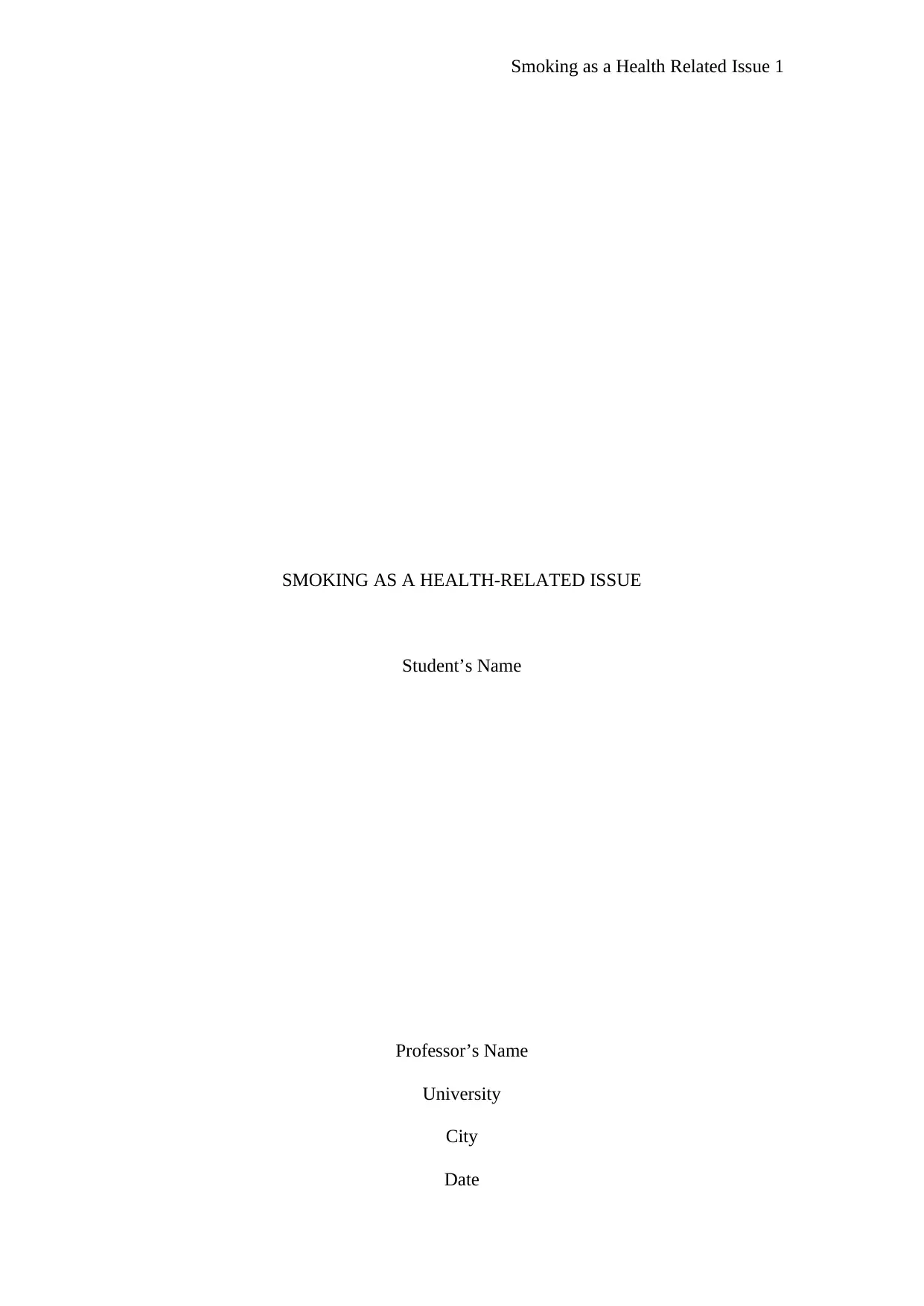
Smoking as a Health Related Issue 1
SMOKING AS A HEALTH-RELATED ISSUE
Student’s Name
Professor’s Name
University
City
Date
SMOKING AS A HEALTH-RELATED ISSUE
Student’s Name
Professor’s Name
University
City
Date
Secure Best Marks with AI Grader
Need help grading? Try our AI Grader for instant feedback on your assignments.
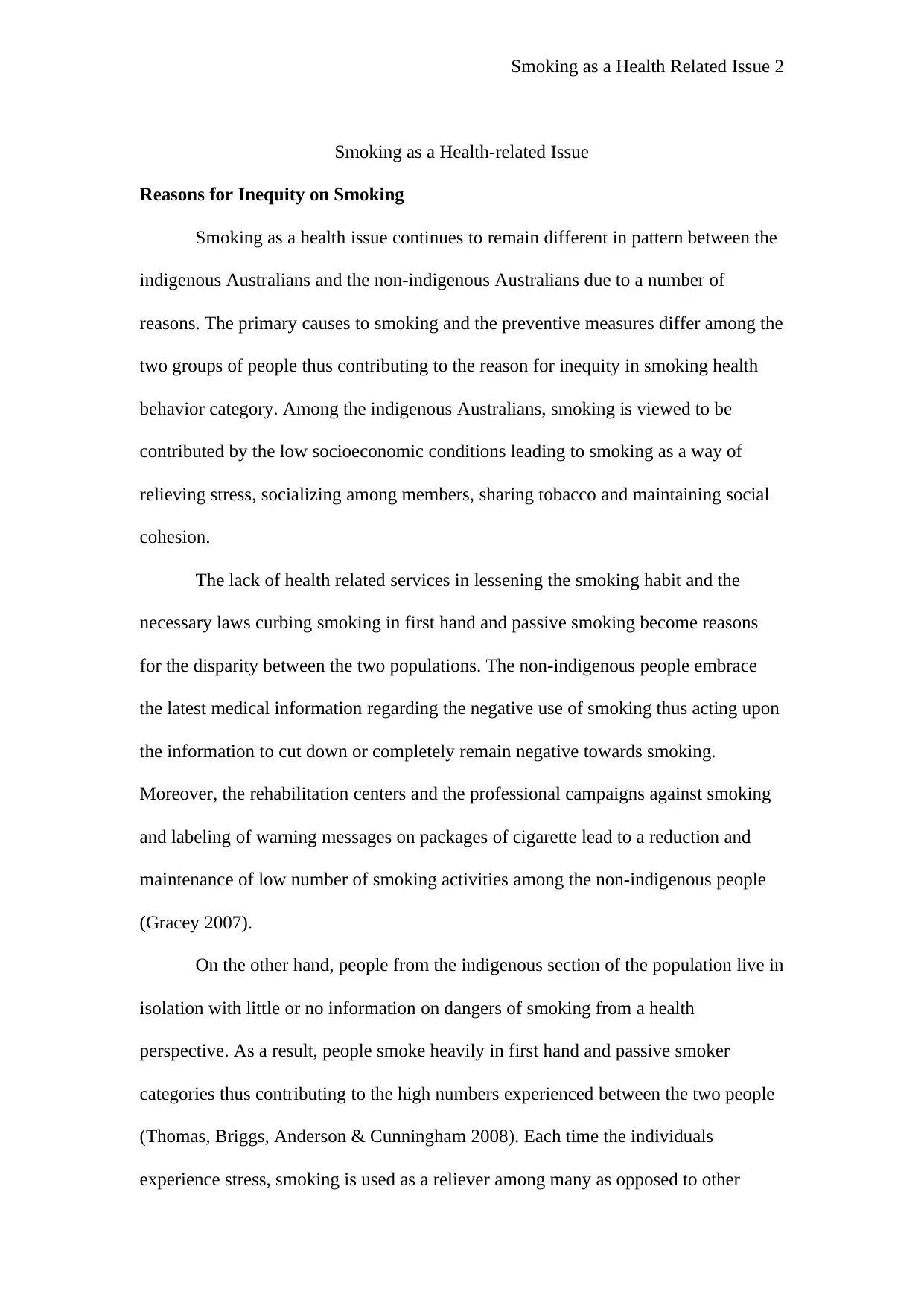
Smoking as a Health Related Issue 2
Smoking as a Health-related Issue
Reasons for Inequity on Smoking
Smoking as a health issue continues to remain different in pattern between the
indigenous Australians and the non-indigenous Australians due to a number of
reasons. The primary causes to smoking and the preventive measures differ among the
two groups of people thus contributing to the reason for inequity in smoking health
behavior category. Among the indigenous Australians, smoking is viewed to be
contributed by the low socioeconomic conditions leading to smoking as a way of
relieving stress, socializing among members, sharing tobacco and maintaining social
cohesion.
The lack of health related services in lessening the smoking habit and the
necessary laws curbing smoking in first hand and passive smoking become reasons
for the disparity between the two populations. The non-indigenous people embrace
the latest medical information regarding the negative use of smoking thus acting upon
the information to cut down or completely remain negative towards smoking.
Moreover, the rehabilitation centers and the professional campaigns against smoking
and labeling of warning messages on packages of cigarette lead to a reduction and
maintenance of low number of smoking activities among the non-indigenous people
(Gracey 2007).
On the other hand, people from the indigenous section of the population live in
isolation with little or no information on dangers of smoking from a health
perspective. As a result, people smoke heavily in first hand and passive smoker
categories thus contributing to the high numbers experienced between the two people
(Thomas, Briggs, Anderson & Cunningham 2008). Each time the individuals
experience stress, smoking is used as a reliever among many as opposed to other
Smoking as a Health-related Issue
Reasons for Inequity on Smoking
Smoking as a health issue continues to remain different in pattern between the
indigenous Australians and the non-indigenous Australians due to a number of
reasons. The primary causes to smoking and the preventive measures differ among the
two groups of people thus contributing to the reason for inequity in smoking health
behavior category. Among the indigenous Australians, smoking is viewed to be
contributed by the low socioeconomic conditions leading to smoking as a way of
relieving stress, socializing among members, sharing tobacco and maintaining social
cohesion.
The lack of health related services in lessening the smoking habit and the
necessary laws curbing smoking in first hand and passive smoking become reasons
for the disparity between the two populations. The non-indigenous people embrace
the latest medical information regarding the negative use of smoking thus acting upon
the information to cut down or completely remain negative towards smoking.
Moreover, the rehabilitation centers and the professional campaigns against smoking
and labeling of warning messages on packages of cigarette lead to a reduction and
maintenance of low number of smoking activities among the non-indigenous people
(Gracey 2007).
On the other hand, people from the indigenous section of the population live in
isolation with little or no information on dangers of smoking from a health
perspective. As a result, people smoke heavily in first hand and passive smoker
categories thus contributing to the high numbers experienced between the two people
(Thomas, Briggs, Anderson & Cunningham 2008). Each time the individuals
experience stress, smoking is used as a reliever among many as opposed to other
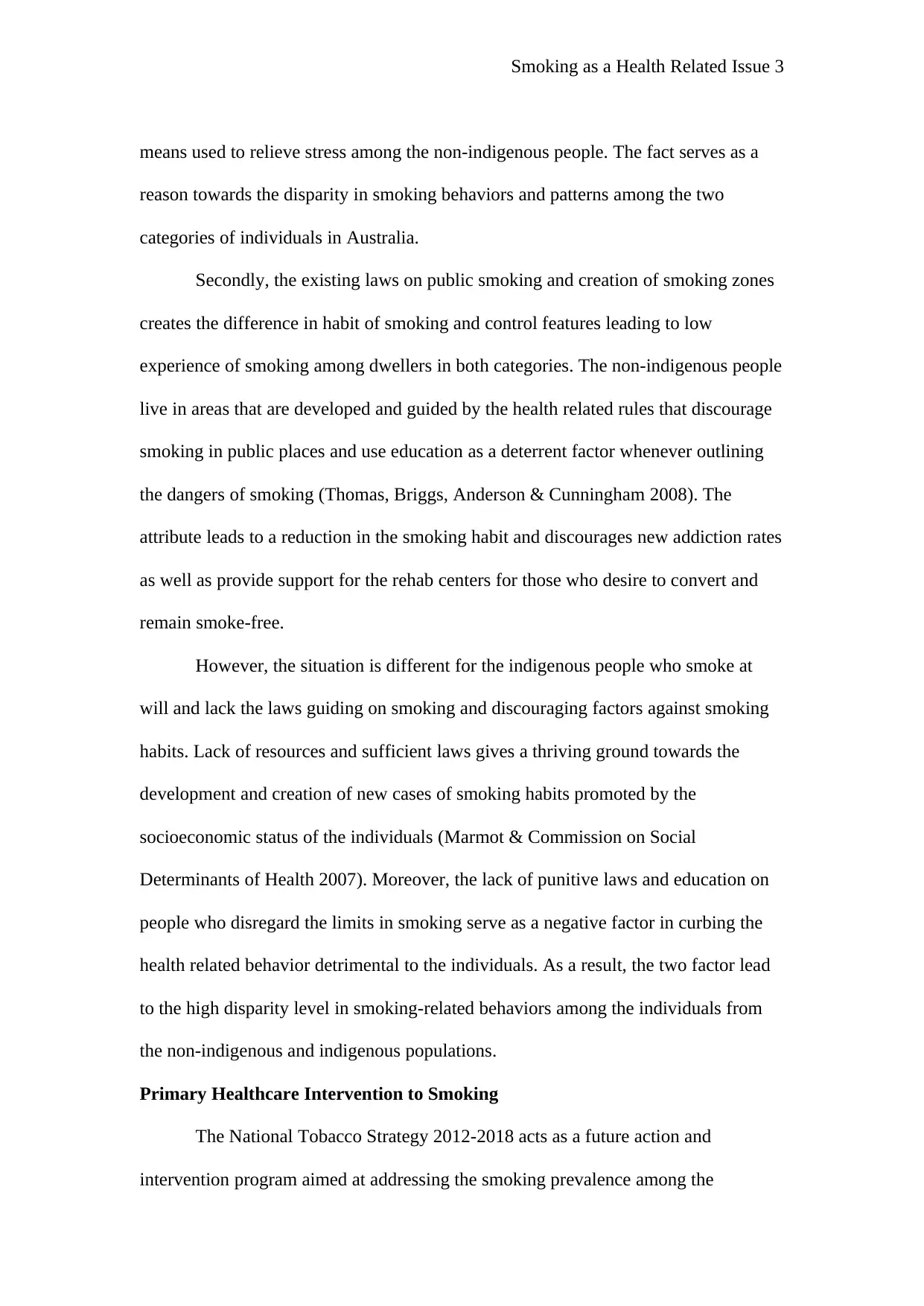
Smoking as a Health Related Issue 3
means used to relieve stress among the non-indigenous people. The fact serves as a
reason towards the disparity in smoking behaviors and patterns among the two
categories of individuals in Australia.
Secondly, the existing laws on public smoking and creation of smoking zones
creates the difference in habit of smoking and control features leading to low
experience of smoking among dwellers in both categories. The non-indigenous people
live in areas that are developed and guided by the health related rules that discourage
smoking in public places and use education as a deterrent factor whenever outlining
the dangers of smoking (Thomas, Briggs, Anderson & Cunningham 2008). The
attribute leads to a reduction in the smoking habit and discourages new addiction rates
as well as provide support for the rehab centers for those who desire to convert and
remain smoke-free.
However, the situation is different for the indigenous people who smoke at
will and lack the laws guiding on smoking and discouraging factors against smoking
habits. Lack of resources and sufficient laws gives a thriving ground towards the
development and creation of new cases of smoking habits promoted by the
socioeconomic status of the individuals (Marmot & Commission on Social
Determinants of Health 2007). Moreover, the lack of punitive laws and education on
people who disregard the limits in smoking serve as a negative factor in curbing the
health related behavior detrimental to the individuals. As a result, the two factor lead
to the high disparity level in smoking-related behaviors among the individuals from
the non-indigenous and indigenous populations.
Primary Healthcare Intervention to Smoking
The National Tobacco Strategy 2012-2018 acts as a future action and
intervention program aimed at addressing the smoking prevalence among the
means used to relieve stress among the non-indigenous people. The fact serves as a
reason towards the disparity in smoking behaviors and patterns among the two
categories of individuals in Australia.
Secondly, the existing laws on public smoking and creation of smoking zones
creates the difference in habit of smoking and control features leading to low
experience of smoking among dwellers in both categories. The non-indigenous people
live in areas that are developed and guided by the health related rules that discourage
smoking in public places and use education as a deterrent factor whenever outlining
the dangers of smoking (Thomas, Briggs, Anderson & Cunningham 2008). The
attribute leads to a reduction in the smoking habit and discourages new addiction rates
as well as provide support for the rehab centers for those who desire to convert and
remain smoke-free.
However, the situation is different for the indigenous people who smoke at
will and lack the laws guiding on smoking and discouraging factors against smoking
habits. Lack of resources and sufficient laws gives a thriving ground towards the
development and creation of new cases of smoking habits promoted by the
socioeconomic status of the individuals (Marmot & Commission on Social
Determinants of Health 2007). Moreover, the lack of punitive laws and education on
people who disregard the limits in smoking serve as a negative factor in curbing the
health related behavior detrimental to the individuals. As a result, the two factor lead
to the high disparity level in smoking-related behaviors among the individuals from
the non-indigenous and indigenous populations.
Primary Healthcare Intervention to Smoking
The National Tobacco Strategy 2012-2018 acts as a future action and
intervention program aimed at addressing the smoking prevalence among the
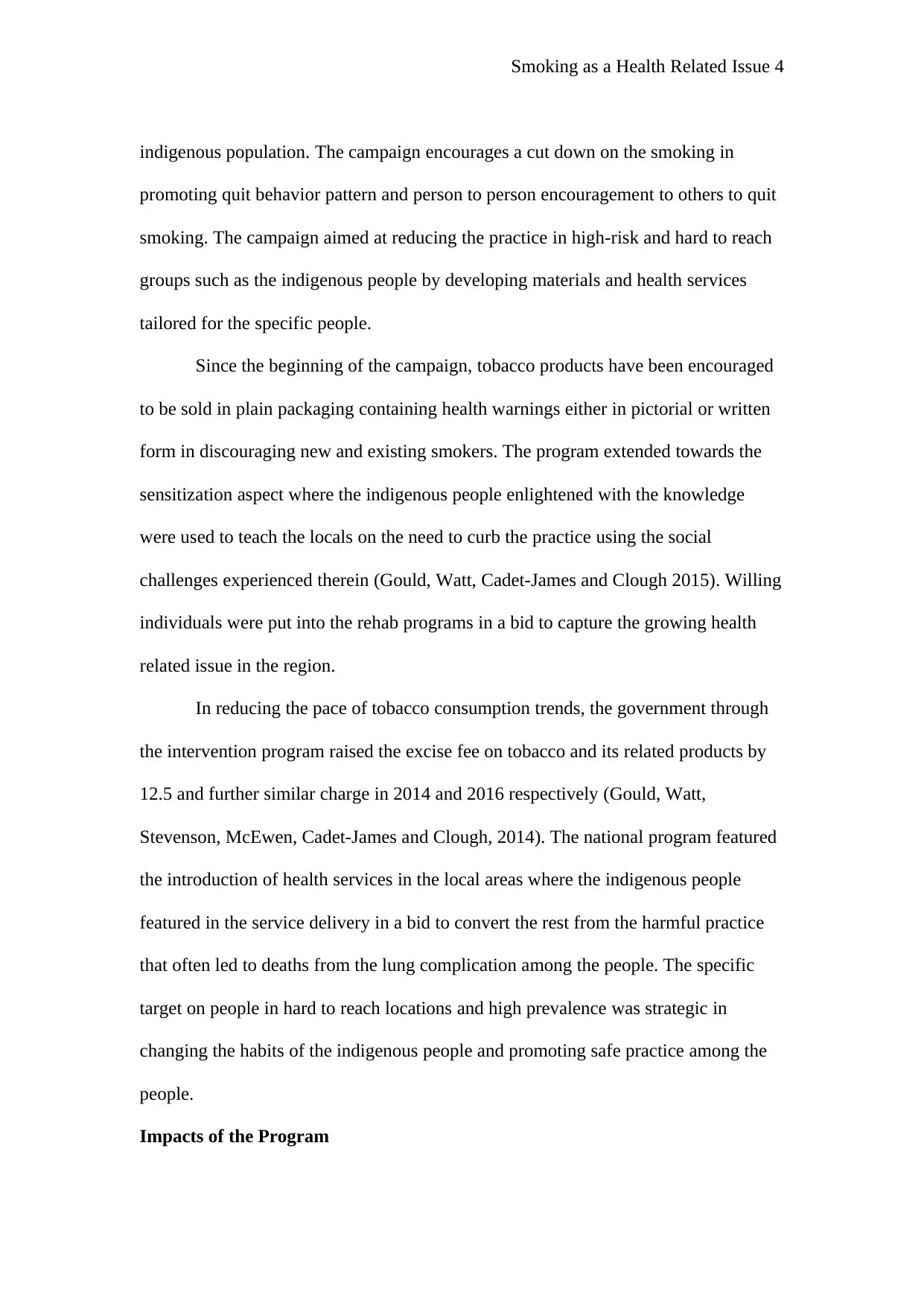
Smoking as a Health Related Issue 4
indigenous population. The campaign encourages a cut down on the smoking in
promoting quit behavior pattern and person to person encouragement to others to quit
smoking. The campaign aimed at reducing the practice in high-risk and hard to reach
groups such as the indigenous people by developing materials and health services
tailored for the specific people.
Since the beginning of the campaign, tobacco products have been encouraged
to be sold in plain packaging containing health warnings either in pictorial or written
form in discouraging new and existing smokers. The program extended towards the
sensitization aspect where the indigenous people enlightened with the knowledge
were used to teach the locals on the need to curb the practice using the social
challenges experienced therein (Gould, Watt, Cadet-James and Clough 2015). Willing
individuals were put into the rehab programs in a bid to capture the growing health
related issue in the region.
In reducing the pace of tobacco consumption trends, the government through
the intervention program raised the excise fee on tobacco and its related products by
12.5 and further similar charge in 2014 and 2016 respectively (Gould, Watt,
Stevenson, McEwen, Cadet-James and Clough, 2014). The national program featured
the introduction of health services in the local areas where the indigenous people
featured in the service delivery in a bid to convert the rest from the harmful practice
that often led to deaths from the lung complication among the people. The specific
target on people in hard to reach locations and high prevalence was strategic in
changing the habits of the indigenous people and promoting safe practice among the
people.
Impacts of the Program
indigenous population. The campaign encourages a cut down on the smoking in
promoting quit behavior pattern and person to person encouragement to others to quit
smoking. The campaign aimed at reducing the practice in high-risk and hard to reach
groups such as the indigenous people by developing materials and health services
tailored for the specific people.
Since the beginning of the campaign, tobacco products have been encouraged
to be sold in plain packaging containing health warnings either in pictorial or written
form in discouraging new and existing smokers. The program extended towards the
sensitization aspect where the indigenous people enlightened with the knowledge
were used to teach the locals on the need to curb the practice using the social
challenges experienced therein (Gould, Watt, Cadet-James and Clough 2015). Willing
individuals were put into the rehab programs in a bid to capture the growing health
related issue in the region.
In reducing the pace of tobacco consumption trends, the government through
the intervention program raised the excise fee on tobacco and its related products by
12.5 and further similar charge in 2014 and 2016 respectively (Gould, Watt,
Stevenson, McEwen, Cadet-James and Clough, 2014). The national program featured
the introduction of health services in the local areas where the indigenous people
featured in the service delivery in a bid to convert the rest from the harmful practice
that often led to deaths from the lung complication among the people. The specific
target on people in hard to reach locations and high prevalence was strategic in
changing the habits of the indigenous people and promoting safe practice among the
people.
Impacts of the Program
Secure Best Marks with AI Grader
Need help grading? Try our AI Grader for instant feedback on your assignments.
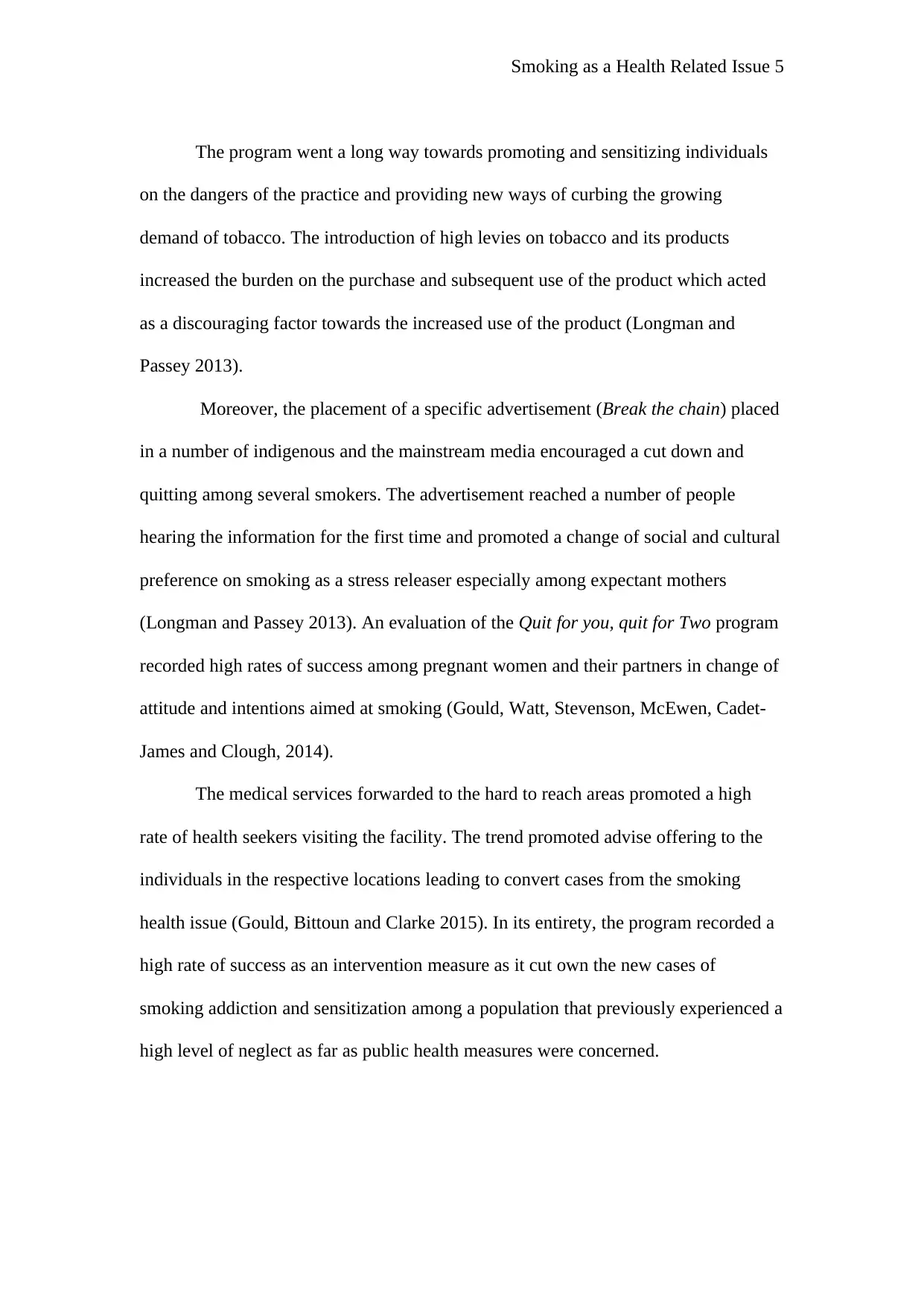
Smoking as a Health Related Issue 5
The program went a long way towards promoting and sensitizing individuals
on the dangers of the practice and providing new ways of curbing the growing
demand of tobacco. The introduction of high levies on tobacco and its products
increased the burden on the purchase and subsequent use of the product which acted
as a discouraging factor towards the increased use of the product (Longman and
Passey 2013).
Moreover, the placement of a specific advertisement (Break the chain) placed
in a number of indigenous and the mainstream media encouraged a cut down and
quitting among several smokers. The advertisement reached a number of people
hearing the information for the first time and promoted a change of social and cultural
preference on smoking as a stress releaser especially among expectant mothers
(Longman and Passey 2013). An evaluation of the Quit for you, quit for Two program
recorded high rates of success among pregnant women and their partners in change of
attitude and intentions aimed at smoking (Gould, Watt, Stevenson, McEwen, Cadet-
James and Clough, 2014).
The medical services forwarded to the hard to reach areas promoted a high
rate of health seekers visiting the facility. The trend promoted advise offering to the
individuals in the respective locations leading to convert cases from the smoking
health issue (Gould, Bittoun and Clarke 2015). In its entirety, the program recorded a
high rate of success as an intervention measure as it cut own the new cases of
smoking addiction and sensitization among a population that previously experienced a
high level of neglect as far as public health measures were concerned.
The program went a long way towards promoting and sensitizing individuals
on the dangers of the practice and providing new ways of curbing the growing
demand of tobacco. The introduction of high levies on tobacco and its products
increased the burden on the purchase and subsequent use of the product which acted
as a discouraging factor towards the increased use of the product (Longman and
Passey 2013).
Moreover, the placement of a specific advertisement (Break the chain) placed
in a number of indigenous and the mainstream media encouraged a cut down and
quitting among several smokers. The advertisement reached a number of people
hearing the information for the first time and promoted a change of social and cultural
preference on smoking as a stress releaser especially among expectant mothers
(Longman and Passey 2013). An evaluation of the Quit for you, quit for Two program
recorded high rates of success among pregnant women and their partners in change of
attitude and intentions aimed at smoking (Gould, Watt, Stevenson, McEwen, Cadet-
James and Clough, 2014).
The medical services forwarded to the hard to reach areas promoted a high
rate of health seekers visiting the facility. The trend promoted advise offering to the
individuals in the respective locations leading to convert cases from the smoking
health issue (Gould, Bittoun and Clarke 2015). In its entirety, the program recorded a
high rate of success as an intervention measure as it cut own the new cases of
smoking addiction and sensitization among a population that previously experienced a
high level of neglect as far as public health measures were concerned.
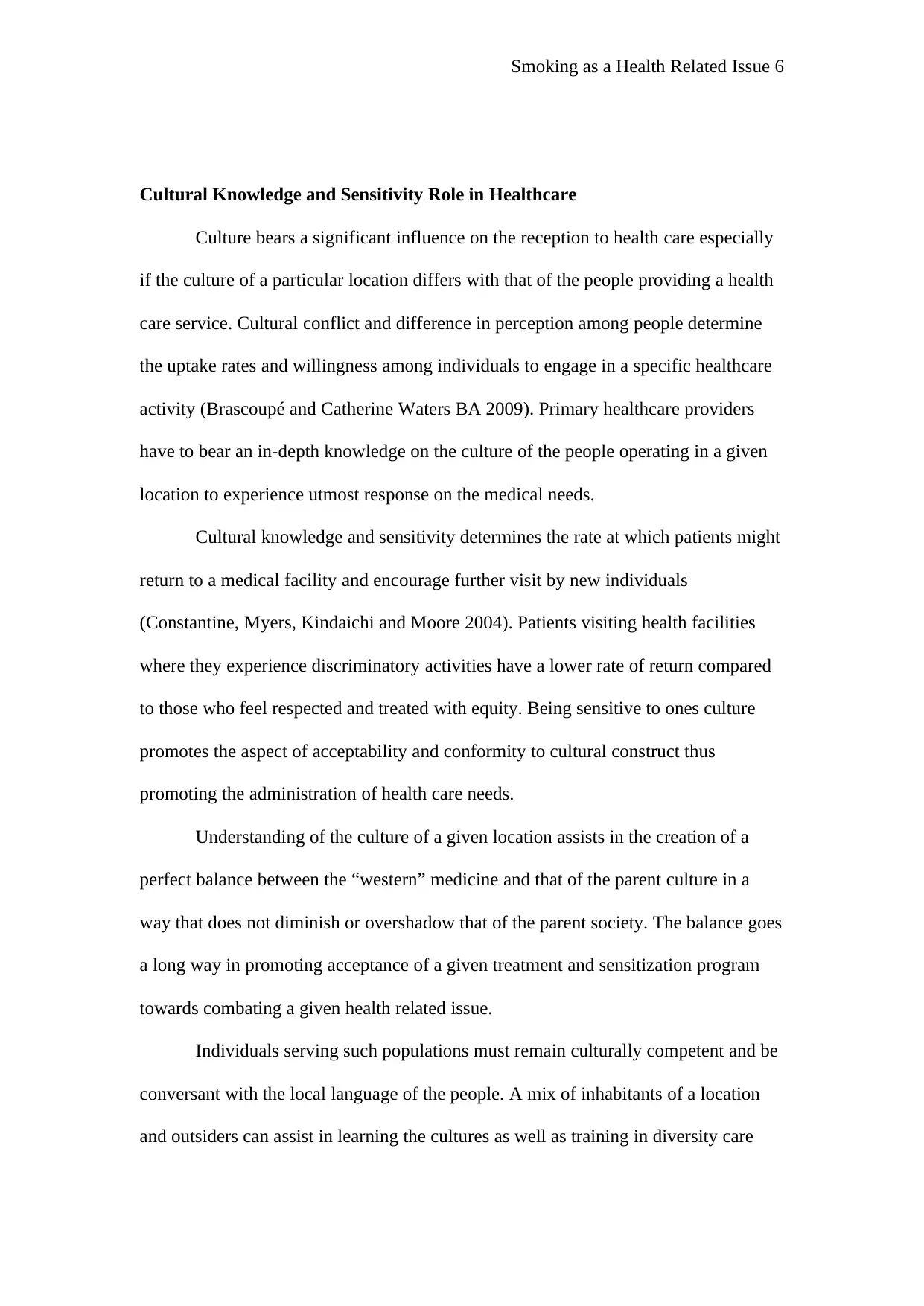
Smoking as a Health Related Issue 6
Cultural Knowledge and Sensitivity Role in Healthcare
Culture bears a significant influence on the reception to health care especially
if the culture of a particular location differs with that of the people providing a health
care service. Cultural conflict and difference in perception among people determine
the uptake rates and willingness among individuals to engage in a specific healthcare
activity (Brascoupé and Catherine Waters BA 2009). Primary healthcare providers
have to bear an in-depth knowledge on the culture of the people operating in a given
location to experience utmost response on the medical needs.
Cultural knowledge and sensitivity determines the rate at which patients might
return to a medical facility and encourage further visit by new individuals
(Constantine, Myers, Kindaichi and Moore 2004). Patients visiting health facilities
where they experience discriminatory activities have a lower rate of return compared
to those who feel respected and treated with equity. Being sensitive to ones culture
promotes the aspect of acceptability and conformity to cultural construct thus
promoting the administration of health care needs.
Understanding of the culture of a given location assists in the creation of a
perfect balance between the “western” medicine and that of the parent culture in a
way that does not diminish or overshadow that of the parent society. The balance goes
a long way in promoting acceptance of a given treatment and sensitization program
towards combating a given health related issue.
Individuals serving such populations must remain culturally competent and be
conversant with the local language of the people. A mix of inhabitants of a location
and outsiders can assist in learning the cultures as well as training in diversity care
Cultural Knowledge and Sensitivity Role in Healthcare
Culture bears a significant influence on the reception to health care especially
if the culture of a particular location differs with that of the people providing a health
care service. Cultural conflict and difference in perception among people determine
the uptake rates and willingness among individuals to engage in a specific healthcare
activity (Brascoupé and Catherine Waters BA 2009). Primary healthcare providers
have to bear an in-depth knowledge on the culture of the people operating in a given
location to experience utmost response on the medical needs.
Cultural knowledge and sensitivity determines the rate at which patients might
return to a medical facility and encourage further visit by new individuals
(Constantine, Myers, Kindaichi and Moore 2004). Patients visiting health facilities
where they experience discriminatory activities have a lower rate of return compared
to those who feel respected and treated with equity. Being sensitive to ones culture
promotes the aspect of acceptability and conformity to cultural construct thus
promoting the administration of health care needs.
Understanding of the culture of a given location assists in the creation of a
perfect balance between the “western” medicine and that of the parent culture in a
way that does not diminish or overshadow that of the parent society. The balance goes
a long way in promoting acceptance of a given treatment and sensitization program
towards combating a given health related issue.
Individuals serving such populations must remain culturally competent and be
conversant with the local language of the people. A mix of inhabitants of a location
and outsiders can assist in learning the cultures as well as training in diversity care

Smoking as a Health Related Issue 7
and management to avoid raising challenges that might impede full administration of
healthcare rights to a given section of people.
Example
The aboriginal people have engaged in smoking for a long time and have been
part of their culture in as far as socialization is concerned. Individuals in their free
time would engage in tobacco smoking for pleasure and relieve of stress in the
society. Over time, the trend would be passed to the younger generation with no limits
towards the number of cigars to be used thus developing a health related issue (King,
Smith and Gracey 2009). In addressing the health concern, the health providers must
approach the issue from a professional manner where the cultural awareness and
sensitivity must be studied for best experience to be achieved among the population.
Cultural sensitivity involves accepting the practice as legal among the people
and only dealing with the dangers of the same while changing the perceptions of the
individuals. In the intervention program against smoking, the health care sector used
advertisement on the dangers of smoking as opposed to ruling out smoking as an
illegal activity (Papadopoulos, Tilki, and Lees 2004). Once people begin to realize the
need to cut down on the smoking patterns, the rate of smoking gradually diminishes
reaching the targeted levels observed in other areas of the mainstream society.
As opposed to total banish, the sensitization would record a high rate of visits
to the medical facility and rehab centers in search of total healing and delivery from
the effects of smoking among the indigenous people. The staff dealing with the people
from the sensitization to the treatment stages were conversant with the culture and
remained sensitive to avoid damaging their egos and interfering with the beliefs of the
people. As a result, the measures succeeded in reducing the smoking rates among the
indigenous populations.
and management to avoid raising challenges that might impede full administration of
healthcare rights to a given section of people.
Example
The aboriginal people have engaged in smoking for a long time and have been
part of their culture in as far as socialization is concerned. Individuals in their free
time would engage in tobacco smoking for pleasure and relieve of stress in the
society. Over time, the trend would be passed to the younger generation with no limits
towards the number of cigars to be used thus developing a health related issue (King,
Smith and Gracey 2009). In addressing the health concern, the health providers must
approach the issue from a professional manner where the cultural awareness and
sensitivity must be studied for best experience to be achieved among the population.
Cultural sensitivity involves accepting the practice as legal among the people
and only dealing with the dangers of the same while changing the perceptions of the
individuals. In the intervention program against smoking, the health care sector used
advertisement on the dangers of smoking as opposed to ruling out smoking as an
illegal activity (Papadopoulos, Tilki, and Lees 2004). Once people begin to realize the
need to cut down on the smoking patterns, the rate of smoking gradually diminishes
reaching the targeted levels observed in other areas of the mainstream society.
As opposed to total banish, the sensitization would record a high rate of visits
to the medical facility and rehab centers in search of total healing and delivery from
the effects of smoking among the indigenous people. The staff dealing with the people
from the sensitization to the treatment stages were conversant with the culture and
remained sensitive to avoid damaging their egos and interfering with the beliefs of the
people. As a result, the measures succeeded in reducing the smoking rates among the
indigenous populations.
Paraphrase This Document
Need a fresh take? Get an instant paraphrase of this document with our AI Paraphraser
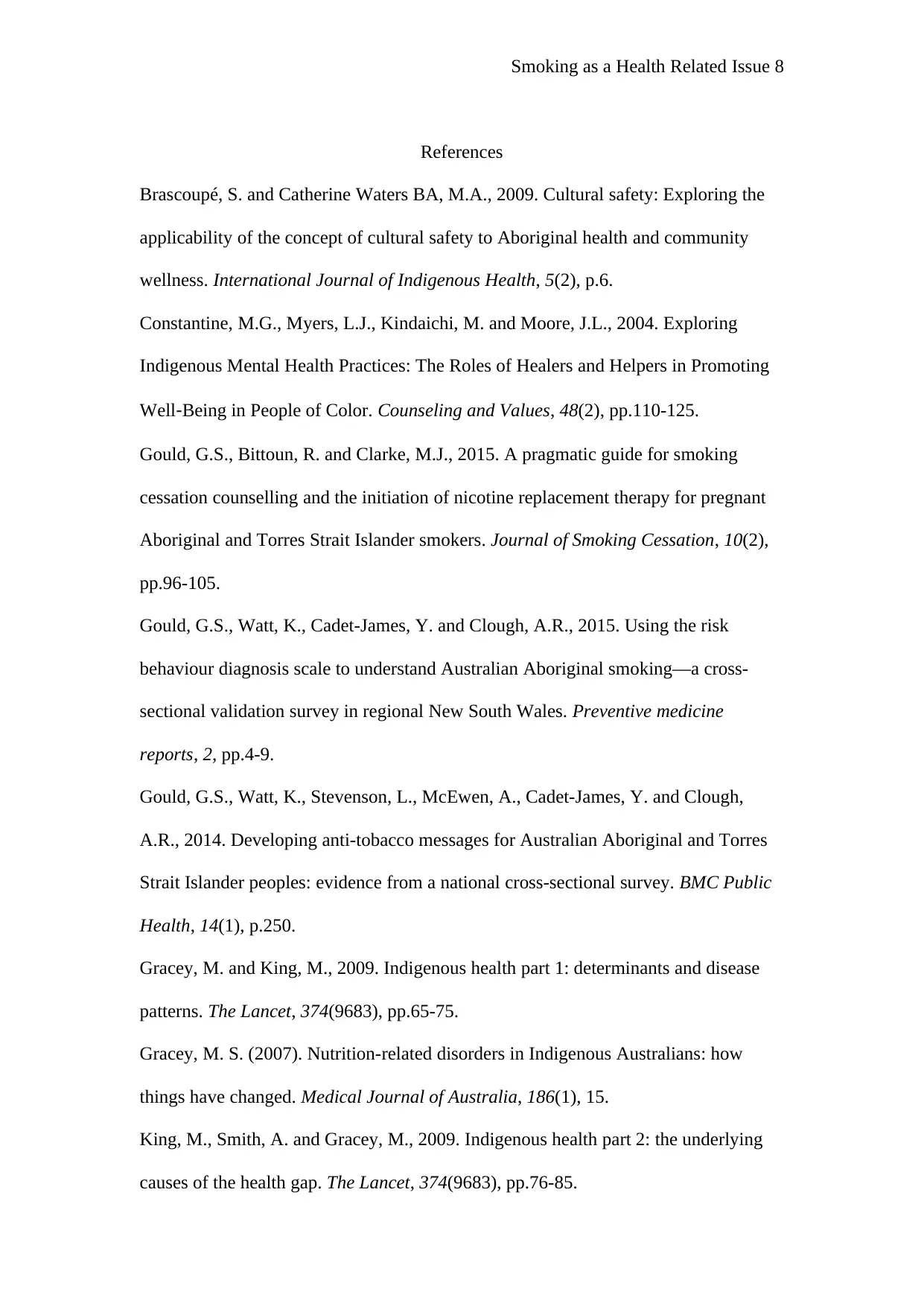
Smoking as a Health Related Issue 8
References
Brascoupé, S. and Catherine Waters BA, M.A., 2009. Cultural safety: Exploring the
applicability of the concept of cultural safety to Aboriginal health and community
wellness. International Journal of Indigenous Health, 5(2), p.6.
Constantine, M.G., Myers, L.J., Kindaichi, M. and Moore, J.L., 2004. Exploring
Indigenous Mental Health Practices: The Roles of Healers and Helpers in Promoting
Well‐Being in People of Color. Counseling and Values, 48(2), pp.110-125.
Gould, G.S., Bittoun, R. and Clarke, M.J., 2015. A pragmatic guide for smoking
cessation counselling and the initiation of nicotine replacement therapy for pregnant
Aboriginal and Torres Strait Islander smokers. Journal of Smoking Cessation, 10(2),
pp.96-105.
Gould, G.S., Watt, K., Cadet-James, Y. and Clough, A.R., 2015. Using the risk
behaviour diagnosis scale to understand Australian Aboriginal smoking—a cross-
sectional validation survey in regional New South Wales. Preventive medicine
reports, 2, pp.4-9.
Gould, G.S., Watt, K., Stevenson, L., McEwen, A., Cadet-James, Y. and Clough,
A.R., 2014. Developing anti-tobacco messages for Australian Aboriginal and Torres
Strait Islander peoples: evidence from a national cross-sectional survey. BMC Public
Health, 14(1), p.250.
Gracey, M. and King, M., 2009. Indigenous health part 1: determinants and disease
patterns. The Lancet, 374(9683), pp.65-75.
Gracey, M. S. (2007). Nutrition-related disorders in Indigenous Australians: how
things have changed. Medical Journal of Australia, 186(1), 15.
King, M., Smith, A. and Gracey, M., 2009. Indigenous health part 2: the underlying
causes of the health gap. The Lancet, 374(9683), pp.76-85.
References
Brascoupé, S. and Catherine Waters BA, M.A., 2009. Cultural safety: Exploring the
applicability of the concept of cultural safety to Aboriginal health and community
wellness. International Journal of Indigenous Health, 5(2), p.6.
Constantine, M.G., Myers, L.J., Kindaichi, M. and Moore, J.L., 2004. Exploring
Indigenous Mental Health Practices: The Roles of Healers and Helpers in Promoting
Well‐Being in People of Color. Counseling and Values, 48(2), pp.110-125.
Gould, G.S., Bittoun, R. and Clarke, M.J., 2015. A pragmatic guide for smoking
cessation counselling and the initiation of nicotine replacement therapy for pregnant
Aboriginal and Torres Strait Islander smokers. Journal of Smoking Cessation, 10(2),
pp.96-105.
Gould, G.S., Watt, K., Cadet-James, Y. and Clough, A.R., 2015. Using the risk
behaviour diagnosis scale to understand Australian Aboriginal smoking—a cross-
sectional validation survey in regional New South Wales. Preventive medicine
reports, 2, pp.4-9.
Gould, G.S., Watt, K., Stevenson, L., McEwen, A., Cadet-James, Y. and Clough,
A.R., 2014. Developing anti-tobacco messages for Australian Aboriginal and Torres
Strait Islander peoples: evidence from a national cross-sectional survey. BMC Public
Health, 14(1), p.250.
Gracey, M. and King, M., 2009. Indigenous health part 1: determinants and disease
patterns. The Lancet, 374(9683), pp.65-75.
Gracey, M. S. (2007). Nutrition-related disorders in Indigenous Australians: how
things have changed. Medical Journal of Australia, 186(1), 15.
King, M., Smith, A. and Gracey, M., 2009. Indigenous health part 2: the underlying
causes of the health gap. The Lancet, 374(9683), pp.76-85.
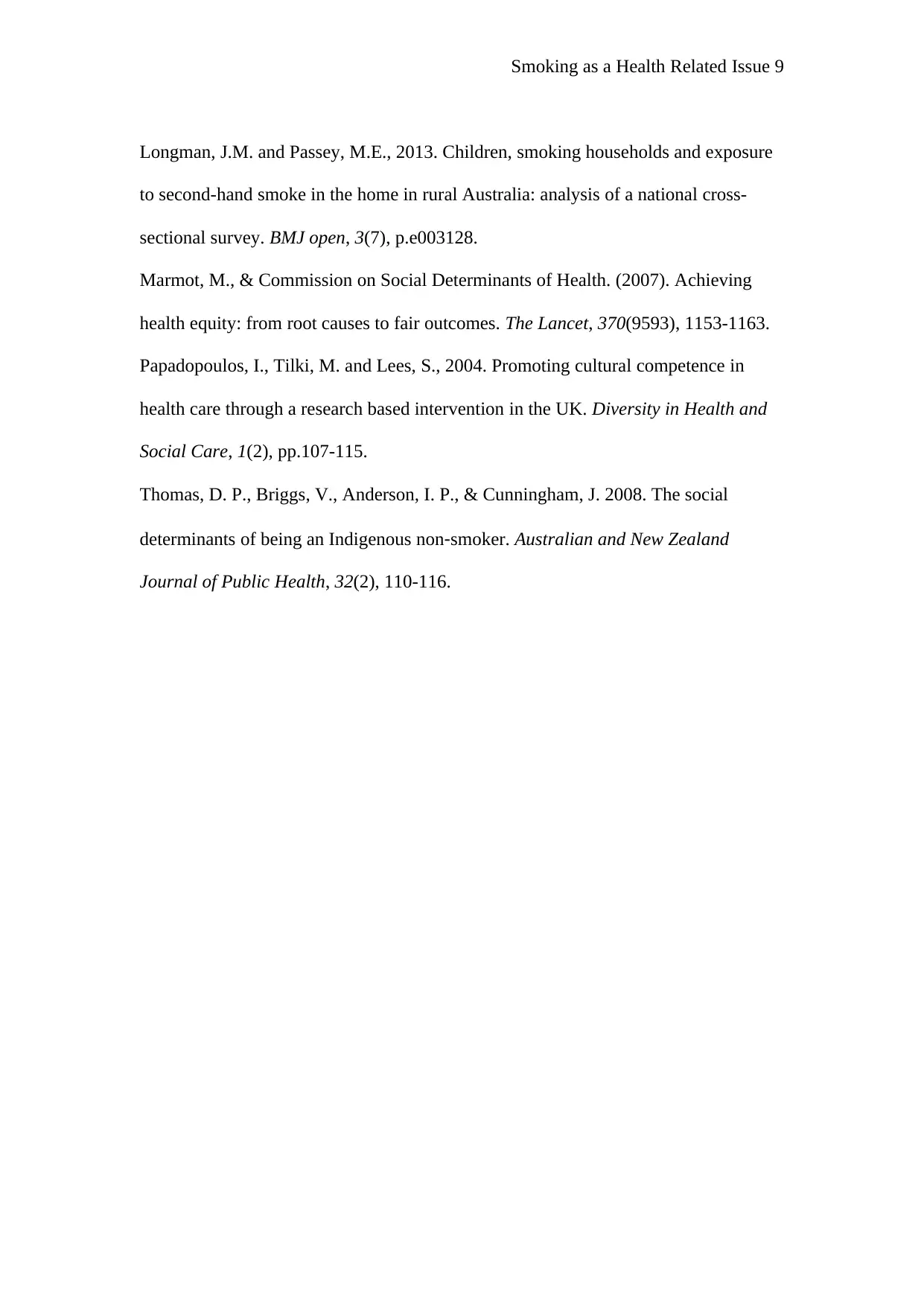
Smoking as a Health Related Issue 9
Longman, J.M. and Passey, M.E., 2013. Children, smoking households and exposure
to second-hand smoke in the home in rural Australia: analysis of a national cross-
sectional survey. BMJ open, 3(7), p.e003128.
Marmot, M., & Commission on Social Determinants of Health. (2007). Achieving
health equity: from root causes to fair outcomes. The Lancet, 370(9593), 1153-1163.
Papadopoulos, I., Tilki, M. and Lees, S., 2004. Promoting cultural competence in
health care through a research based intervention in the UK. Diversity in Health and
Social Care, 1(2), pp.107-115.
Thomas, D. P., Briggs, V., Anderson, I. P., & Cunningham, J. 2008. The social
determinants of being an Indigenous non‐smoker. Australian and New Zealand
Journal of Public Health, 32(2), 110-116.
Longman, J.M. and Passey, M.E., 2013. Children, smoking households and exposure
to second-hand smoke in the home in rural Australia: analysis of a national cross-
sectional survey. BMJ open, 3(7), p.e003128.
Marmot, M., & Commission on Social Determinants of Health. (2007). Achieving
health equity: from root causes to fair outcomes. The Lancet, 370(9593), 1153-1163.
Papadopoulos, I., Tilki, M. and Lees, S., 2004. Promoting cultural competence in
health care through a research based intervention in the UK. Diversity in Health and
Social Care, 1(2), pp.107-115.
Thomas, D. P., Briggs, V., Anderson, I. P., & Cunningham, J. 2008. The social
determinants of being an Indigenous non‐smoker. Australian and New Zealand
Journal of Public Health, 32(2), 110-116.
1 out of 9
Related Documents
Your All-in-One AI-Powered Toolkit for Academic Success.
+13062052269
info@desklib.com
Available 24*7 on WhatsApp / Email
![[object Object]](/_next/static/media/star-bottom.7253800d.svg)
Unlock your academic potential
© 2024 | Zucol Services PVT LTD | All rights reserved.




